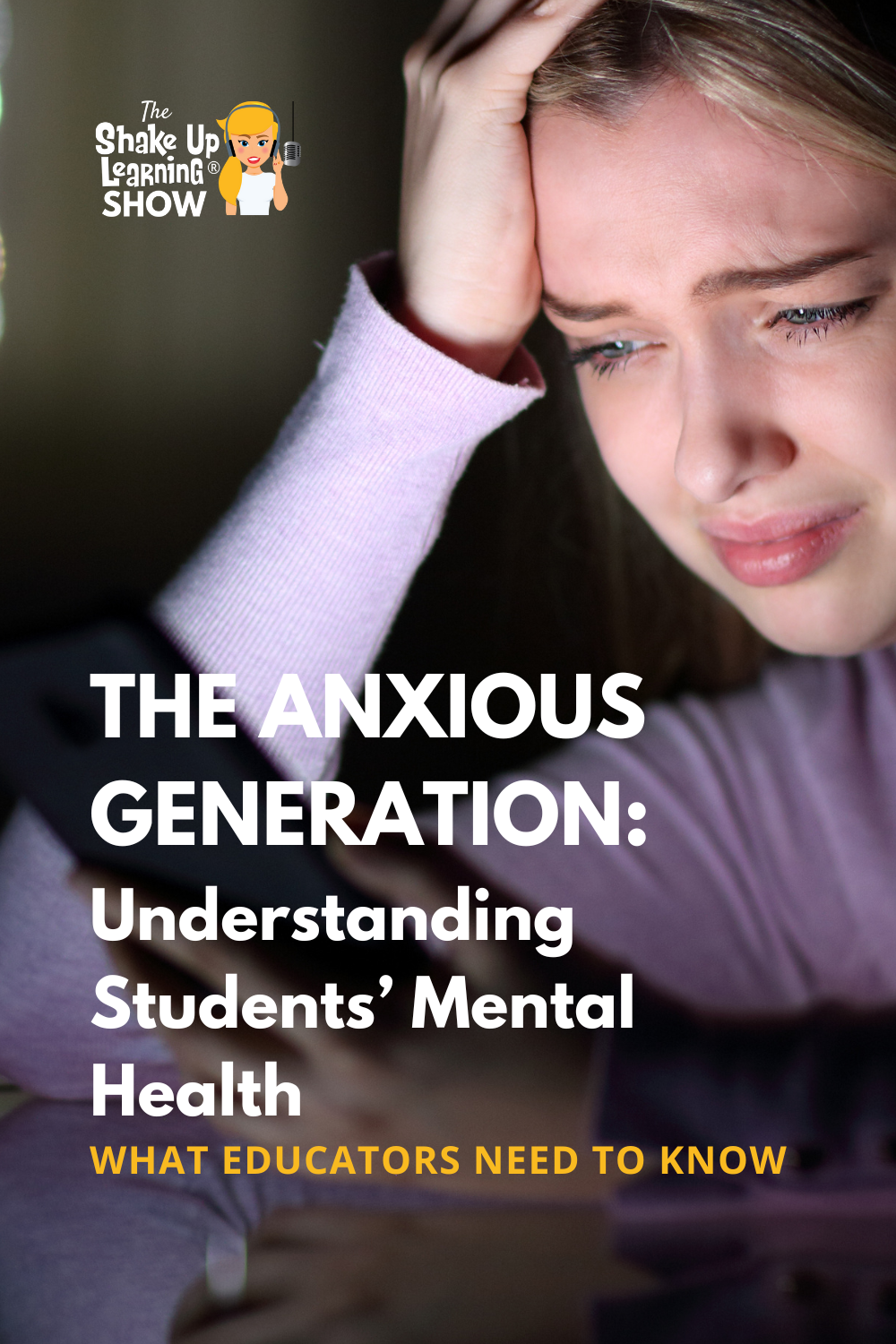Are smartphones and social media harming student mental health? If you’ve been in the classroom recently, you’ve likely noticed a rise in anxiety, shorter attention spans, and a decline in social skills.It’s not just in your head—research shows that today’s students are facing a mental health crisis like never before.In Episode 221 of the Shake Up Learning Show, we dive into this urgent issue through the lens of Jonathan Haidt’s book, The Anxious Generation.
This book explores how childhood has been fundamentally rewired—kids today are overprotected in the real world but dangerously underprotected online.Listen to this episode: The Anxious Generation: Understanding Students’ Mental Health The Rise of Anxiety & the Rewiring of Childhood Childhood today looks vastly different from what it did just a couple of decades ago.Gone are the days when kids spent hours outdoors, riding bikes, exploring their neighborhoods, and developing independence through unstructured play.
Instead, many children and teens now spend the majority of their free time in digital spaces, scrolling through social media, engaging in online gaming, and communicating primarily through screens rather than face-to-face interactions.Jonathan Haidt argues that this shift has led to a fundamental rewiring of childhood, one that has serious consequences for students’ emotional and social development.As real-world independence has declined, children have become more isolated, heavily reliant on technology, and less equipped to handle life’s challenges.
With fewer opportunities to take risks, problem-solve, and navigate social situations in person, many students struggle with emotional regulation and resilience.The constant exposure to curated online personas and social comparison has also exacerbated anxiety and depression, particularly among teens.To make matters worse, the rise of AI-powered social media algorithms has only intensified the problem.
These platforms are designed to keep users engaged for as long as possible, serving them highly targeted, emotionally charged content that makes it even harder to disconnect.As a result, students are not just spending more time online—they’re becoming more dependent on digital interactions while their ability to focus, connect in person, and navigate the real world continues to decline.*Related: No Child Left Offline: Confronting the Mental Health Crisis in the Smartphone Era The Case for Phone-Free Schools With the growing concerns surrounding student mental health and focus, Haidt makes a compelling case for removing smartphones from schools altogether.
Research has shown that the presence of smartphones in classrooms contributes to increased distractions, heightened anxiety, and lower academic performance.When students have unrestricted access to their devices, their attention is fragmented, making it harder for them to engage in deep learning, meaningful discussions, and in-person social interactions.Schools that have implemented phone-free policies report better student engagement, improved academic outcomes, and stronger classroom communities.
While technology certainly has a valuable role in education, many experts argue that the use of personal smartphones during the school day does far more harm than good.The challenge now lies in striking a balance—leveraging technology for learning while ensuring that students aren’t overwhelmed by its negative effects.Is it time for schools to implement stronger restrictions on smartphones? Should classrooms go phone-free? These are questions that educators, administrators, and parents must grapple with as we work toward creating a healthier digital culture for students.
*Related: Protecting Students in a Digital World What Educators Can Do The growing dependence on technology isn’t just a parenting issue—schools and educators have an important role to play in helping students develop healthier tech habits.Instead of letting smartphones dictate classroom culture, educators can take intentional steps to foster real-world connections, critical thinking, and responsible technology use.One of the most impactful strategies is to prioritize face-to-face interaction in the classroom.
Encouraging students to engage in discussions, group work, and hands-on activities helps them build communication skills and social confidence.Additionally, educators can integrate digital literacy lessons, teaching students how to critically evaluate online content, recognize misinformation, and navigate AI-generated media responsibly.Setting clear technology boundaries is also essential.
This may include limiting screen time during class, implementing no-phone zones, or using tech tools only when they enhance—not replace—meaningful learning.Lastly, teachers and school leaders should model healthy technology habits by demonstrating intentional, purposeful tech use rather than mindless scrolling or unnecessary screen reliance.The challenge of managing technology in schools is complex, but by taking proactive steps, educators can help students reclaim focus, strengthen real-world skills, and develop a healthier relationship with digital tools.
*Related: Online Safety for Students at School (and at home) Grab Your Copy of The Anxious Generation To get the most out of this book study, I highly recommend getting your own copy of The Anxious Generation by Jonathan Haidt.This eye-opening read will help you understand how smartphones and social media are reshaping childhood—and what we can do about it.Get your copy here Join the Book Study + Special Offer! Want to dive deeper into these ideas? We’re launching a six-week book study on The Anxious Generation starting March 5 inside the Shake Up Learning Community! Weekly discussions to unpack key ideas.
Reflection questions to help apply insights in your school.Connect with other educators to share strategies and experiences.️ 3 Hours PD Credit! JOIN NOW & SAVE! Valentine’s Day Sale – 50% OFF All-Access Membership! Join the quarterly plan for just $28.50 (normally $57) and get full access to the book study, PD courses, and exclusive resources.
Sale ends February 15! Don’t miss this chance to save big and join the conversation! Sign up here Shake Up Learning 2023.Unauthorized use and/or duplication of this material without express and written permission from this blog’s author and/or owner is strictly prohibited.Excerpts and links may be used, provided that full and clear credit is given to Kasey Bell and Shake Up Learning with appropriate and specific direction to the original content on ShakeUpLearning.com.
See: Copyright Policy.









